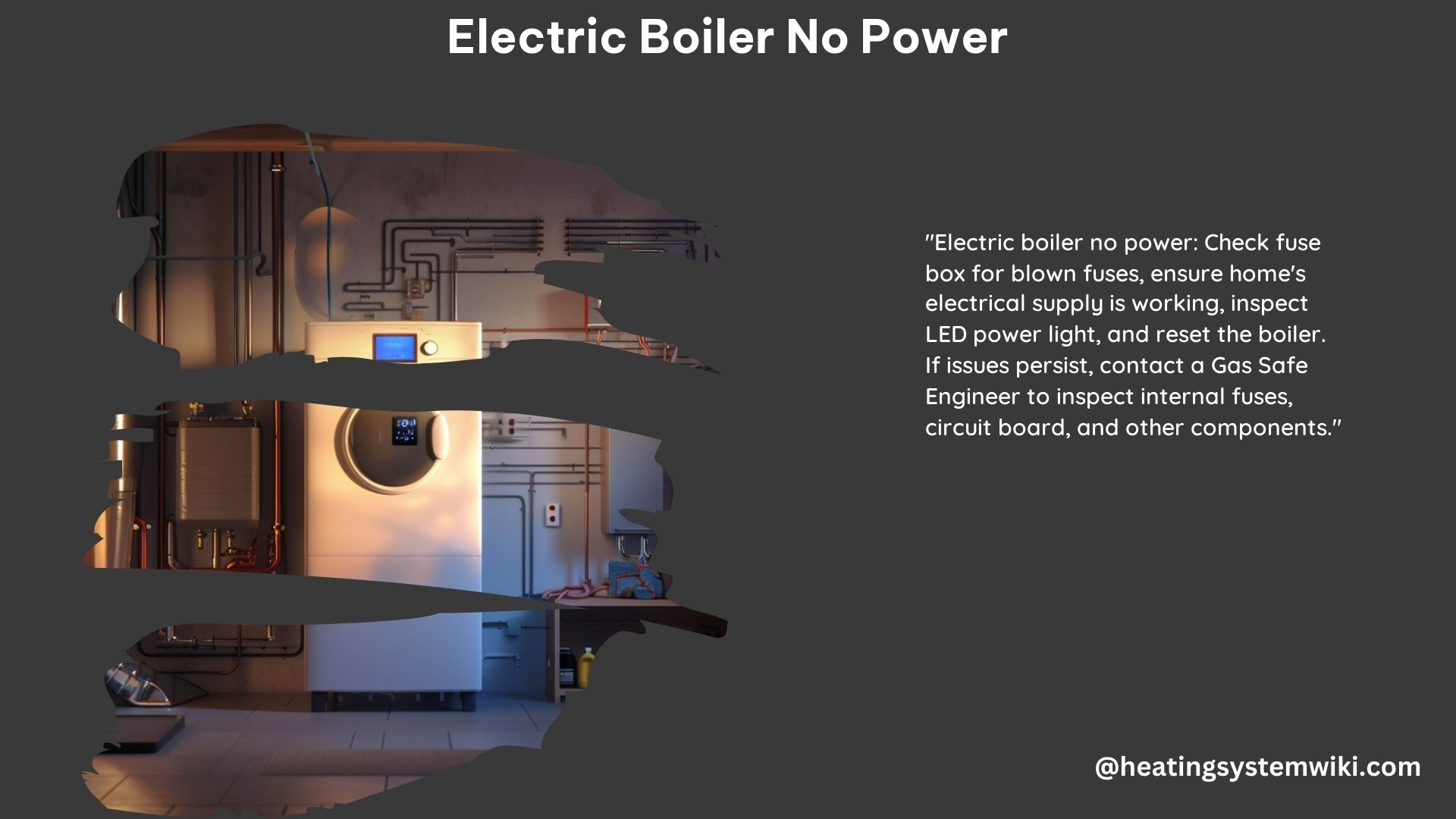If your electric boiler has no power, it can be a frustrating and concerning issue. However, with the right knowledge and a step-by-step approach, you can often diagnose and resolve the problem yourself. This comprehensive guide will walk you through the common causes of electric boiler power failure and provide detailed instructions on how to check and fix the issue.
Causes of No Power to Electric Boiler
1. Tripped RCD or MCB
One of the most common reasons for an electric boiler losing power is a tripped Residual Current Device (RCD) or Miniature Circuit Breaker (MCB) in your home’s fuse board (consumer unit). When an RCD or MCB trips, it cuts off the power supply to the affected circuit to prevent electrical hazards.
To check for a tripped RCD or MCB:
– Locate your home’s fuse board or consumer unit.
– Examine the switches – if any are pointing downwards, it means the circuit is turned off.
– Flip the tripped switch back up to restore power to the electric boiler.
– Ensure all isolation switches are also turned on.
If the RCD or MCB continues to trip, there may be an underlying electrical issue that needs to be addressed by a qualified electrician.
2. Faulty Thermostat
A malfunctioning thermostat can prevent the electric boiler from receiving power and turning on. The thermostat is responsible for monitoring the temperature and signaling the boiler to start heating when the temperature drops below the set point.
To check the thermostat:
– Locate the thermostat and ensure it is set to the desired temperature.
– Use a multimeter to test the thermostat for continuity. If the thermostat is faulty, it will need to be replaced.
– Alternatively, you can bypass the thermostat by connecting the boiler’s power supply directly to the boiler’s control panel. If the boiler then turns on, the thermostat is likely the issue.
3. Blown Fuses
Electric boilers typically have internal fuses that protect the electrical components from overloads or short circuits. If these fuses are blown, the boiler will not receive power.
To check the boiler’s internal fuses:
– Locate the fuse box or compartment within the boiler, usually near the control panel.
– Visually inspect the fuses for any signs of damage or discoloration, which would indicate a blown fuse.
– Use a multimeter to test the fuses and ensure they are functioning correctly.
– If a fuse is blown, replace it with a new one of the same amperage rating, typically 3 amps (3A).
Replacing the fuses may require the assistance of a Gas Safe Registered heating engineer, as it involves working on the boiler’s internal electrical components.
4. Faulty Circuit Board
If the boiler’s internal fuses are intact, but the boiler still has no power, the issue may be with the circuit board (also known as the Printed Circuit Board or PCB).
The circuit board is the “brain” of the electric boiler, controlling the various components and functions. If the circuit board is faulty, it can prevent the boiler from receiving or distributing power.
Diagnosing and replacing a faulty circuit board typically requires the expertise of a qualified heating engineer, as it involves disassembling the boiler and replacing the specialized component.
The cost of a replacement circuit board can range from £80 to £250, depending on the boiler model, plus labor costs.
5. LED Power Light Issues
In some cases, the issue may not be with the boiler’s power supply, but rather with the LED power light. A faulty LED power light can make it appear as if the boiler is not receiving power, even when the electrical components are functioning correctly.
To check the LED power light:
– Locate the power light on the boiler’s control panel.
– Visually inspect the light for any signs of damage or discoloration.
– Use a multimeter to test the power light’s continuity and ensure it is working correctly.
– If the power light is faulty, replace it with a new one of the same type and rating.
Steps to Check and Fix

-
Check Electrical Supply: Before delving into the boiler’s internal components, ensure that the electrical supply to your home is working correctly. Test other appliances and lights to confirm that the issue is specific to the electric boiler.
-
Check Fuse Board and Boiler Fuses: Inspect your home’s fuse board or consumer unit for any tripped RCDs or MCBs, and reset them if necessary. Then, check the boiler’s internal fuses and replace any that are blown.
-
Check Thermostat and Boiler Components: Verify that the thermostat is functioning correctly by testing it with a multimeter. Also, inspect the boiler’s other components, such as pumps, fans, and mechanical timers, for any signs of failure.
-
Reset the Boiler: After resolving any electrical issues, reset the boiler by pressing and holding the reset button for approximately 10 seconds. This can help clear any temporary glitches or errors.
Professional Assistance
If you are unsure about performing these checks or if the problem persists after trying these solutions, it is recommended to contact a Gas Safe Registered heating engineer for further assistance. They have the necessary expertise and equipment to diagnose and repair more complex issues with your electric boiler.
Technical Specifications
- Fuse Ratings: Boiler fuses are typically rated 3 amps (3A).
- Circuit Board Costs: Replacing a circuit board can cost between £80 and £250, depending on the boiler model, plus labor costs.
References
- https://www.justanswer.co.uk/hvac/nq2gu-electric-boiler-no-power.html
- https://www.thamesboilers.co.uk/no-power-to-boiler/
- https://heatable.co.uk/boiler-advice/no-power-to-boiler
- https://247homerescue.co.uk/blog/no-power-to-boiler-reasons-with-fixes/
- https://corgihomeplan.co.uk/advice/no-power-in-your-boiler
